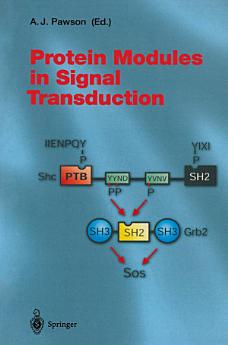Protein Modules in Signal Transduction
Anthony J. Pawson
ธ.ค. 2012 · Current Topics in Microbiology and Immunology หนังสือเล่มที่ 228 · Springer Science & Business Media
eBook
368
หน้า
reportคะแนนและรีวิวไม่ได้รับการตรวจสอบยืนยัน ดูข้อมูลเพิ่มเติม
เกี่ยวกับ eBook เล่มนี้
The external signals that control cellular behavior are chanelled through cell surface receptors, that in turn regulate cytoplasmic signaling pathways. Work over the last ten years has indicated that the activation of these intra- cellular signaling pathways depends on a series of protein-protein and protein-phospholipid interactions mediated by modular polypeptide domains. Through their association with specific peptide motifs, these protein modules define a recognition code through which many aspects of cellular function are controlled. The articles in this book describe the varied features of these domains, and outline the structural, biochemical and genetic evidence that demonstrates their importance in co-ordinating cellular responses to external cues.
ให้คะแนน eBook นี้
แสดงความเห็นของคุณให้เรารับรู้
ข้อมูลในการอ่าน
สมาร์ทโฟนและแท็บเล็ต
ติดตั้งแอป Google Play Books สำหรับ Android และ iPad/iPhone แอปจะซิงค์โดยอัตโนมัติกับบัญชีของคุณ และช่วยให้คุณอ่านแบบออนไลน์หรือออฟไลน์ได้ทุกที่
แล็ปท็อปและคอมพิวเตอร์
คุณฟังหนังสือเสียงที่ซื้อจาก Google Play โดยใช้เว็บเบราว์เซอร์ในคอมพิวเตอร์ได้
eReader และอุปกรณ์อื่นๆ
หากต้องการอ่านบนอุปกรณ์ e-ink เช่น Kobo eReader คุณจะต้องดาวน์โหลดและโอนไฟล์ไปยังอุปกรณ์ของคุณ โปรดทำตามวิธีการอย่างละเอียดในศูนย์ช่วยเหลือเพื่อโอนไฟล์ไปยัง eReader ที่รองรับ







